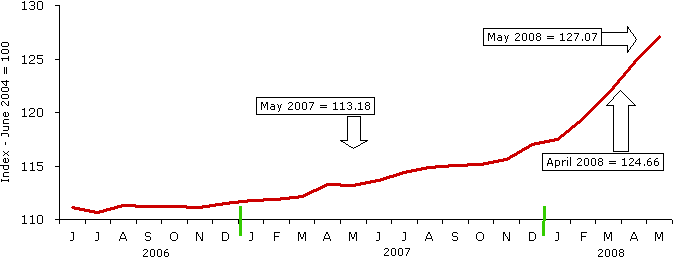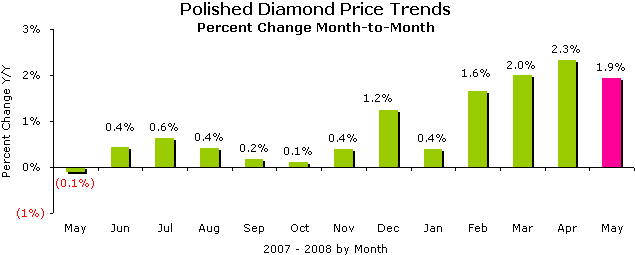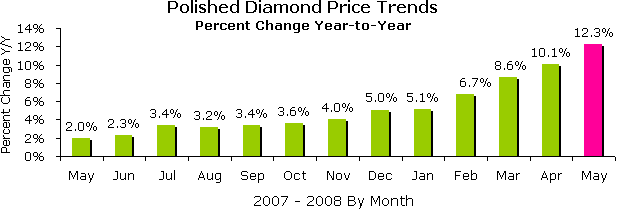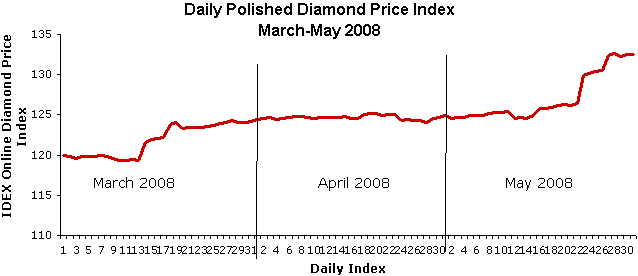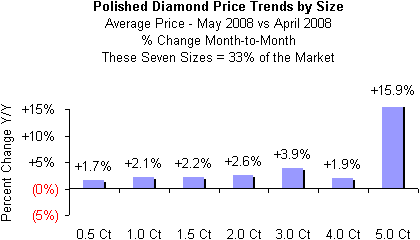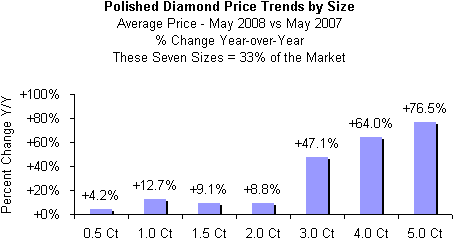IDEX Online Research: Polished Diamond Prices Surge 12.3% in May
June 04, 08
Diamond prices surged again in May, breaking records set in prior months. On a year-over-year basis, diamond prices were up a dramatic 12.3 percent, according to the IDEX Online Polished Diamond Price Index. Even on a month-over-month basis – May 2008 versus April 2008 – diamond prices rose significantly.
Large, high-quality diamonds posted the most remarkable price increases. On a year-over-year basis, three, four, and five carat diamonds posted price increases of 47 percent, 64 percent, and 77 percent respectively.
Even more striking, diamond prices spiked sharply on May 23 and again on May 27, after remaining relatively stable for about two months.
What is behind these leaping diamond prices? Demand continues to surge in many markets, and diamond prices appear to be reflecting true supply and demand. This is a notable shift from the past, when demand in the
The best example of the trend in global markets can be seen with Tiffany & Company’s first quarter results. The company’s sales in the
We view this trend – prices reacting to total global market demand, rather than being pegged to
Our outlook: as long as demand for diamonds and diamond jewelry remains strong, especially in emerging markets, prices are expected rise. Further, since rough diamond prices have been rising faster than polished diamond prices, there is ongoing pressure to pass along those price increases. While we believe the current pace of diamond price inflation won’t continue, there is no reason to suggest that a price pull-back is likely, either.
The graph below summarizes the IDEX Online Polished Diamond Price Index for the past 24 months. This graph represents the composite average prices of all diamonds traded at the wholesale level. The slope of the line has become significantly steeper this year, reflecting rising prices for virtually all polished diamonds.
| IDEX Online Polished Diamond Price Index
|
 |
The graph below summarizes month-to-month changes in global diamond prices for the past thirteen months. In 2007, polished diamond prices showed modest gains during almost every month; however, since February 2008, month-to-month inflation for polished diamonds has been dramatic, as the graph illustrates. .
|
|
 |
While we continue to worry about the sustainability of such large year-over-year price increases in polished diamonds, the market appears to be operating in a true capitalistic supply-versus-demand mode. If demand remains strong, prices will rise. Conversely, if demand weakens, prices could drop. This trend is especially important to note, since the
On a year-over-year basis, polished diamond prices have shown larger and larger gains each month over the past year or so. The graph below summarizes year-over-year monthly polished diamond prices for the global market since the beginning of 2007.
Comparisons are based on the daily average prices during the month versus the same month a year ago (e.g. May 2008 versus May 2007). The year-to-year comparison takes into account the seasonality of polished diamond demand and prices.
|
|
Day-to-Day Polished Diamond Prices Were Steady Until Late in the Month
Diamond prices have been behaving strangely. They seem to hold steady for days or weeks, and then spike irrationally over a one- or two-day period. If the diamond market was regulated – as it will be, if diamond futures trade – you can bet that the commodities exchanges would be investigating these trading patterns, examining each person’s trade. In regulated markets, buyers and sellers can’t hide their identities; the market will know who is selling and who is buying.
Explanations for the price spikes have been offered: for example, diamond buyers are anticipating a reasonably good 2008 holiday season, and they pushed prices up just prior to the all-important JCK Las Vegas show. Others suggest that demand has been strong overseas, and prices are spiking to reflect this robust demand. The falling U.S. dollar has also pushed diamond prices higher. As long as the diamond trading market is unregulated, we don’t have transparency, and we don’t have explanations.
IDEX Online’s recently launched service – Guaranteed Diamond TransactionsTM – has enabled us to begin recording and analyzing individual trades, thus enhancing our insight into the polished diamond price hikes and allowing us to identify their origins. Our future price index reports will include information based on the new service as it gains researchable volume.
With the possibility of diamond futures trading just around the corner, it may be time to ask if diamonds should be traded in Euros or U.S. dollars, or even Rupees, since India is by far the largest producer of cut and polished diamonds in the world, based on units produced. Because diamonds are currently traded in U.S. dollars, the impact of this weakening currency is having an adverse impact on the price of diamonds.
We normally show a one-month daily graph of diamond prices, but it is more instructive to see daily diamond prices on a three-month basis, in order to understand when polished diamond prices actually surged.
In March, there was a sharp spike mid-month, and those higher prices carried over into April. However, while prices were at record levels in April, they were relatively flat throughout the month, a trend that continued into early May. The market was apparently digesting the price spike that occurred in March; many suppliers were waiting to see of prices would hold firm. They were rewarded for their patience: prices were steady in April and early May. However, near the end of May – May 23 and May 27 – diamond prices spiked again.
The following graph illustrates the average price of polished diamonds on a day-by-day basis in March and April 2008.
|
|
Diamond Demand Remains Strong for Large Sizes
Month after month, demand remains robust for larger size, high-quality diamonds. Retail jewelers say that their customers are seeking the best quality gemstones they can afford. It is not just about size; it is also about fire, brilliance and those other markers of a quality diamond. As a result, prices for the larger size diamonds are rising rapidly.
The graph below summarizes the price changes for key sizes of polished diamonds on a month-over-month basis: May 2008 versus April 2008. These seven stone sizes represent about 33 percent of the trading market by value.
|
|
On a year-to-year comparison, polished diamond prices showed a greater bias: prices for large stones in the three-to-five carat range rose much more dramatically while prices of stones two-carat and smaller posted more moderate gains. Did five-carat polished diamonds really rise by nearly 77 percent year-over-year? Ask any diamantaire who deals in large, high-quality stones – they will confirm that prices are spiking daily.
Following February, March, and April, May is the fourth consecutive month in which all key diamond sizes – one-half carat through five-carat stones – showed a price increase on a year-over-year basis. The price increase for smaller stones in the one-half carat size range was modest, but it was up.
The graph below summarizes polished diamond prices by key sizes on a year-over-year basis: May 2008 versus May 2007. These seven sizes represent about one-third of the market, by aggregate value.
|
|
Forecast: Polished Diamond Prices Higher, But Inflation Pace Should Moderate
Economists continue to forecast that global economic growth will decelerate modestly during 2008, particularly among two of the world’s larger economies –
The good news: economic woes in the
Because rough diamond prices are rising at a pace faster than polished diamond prices, there is much pressure on cutters and polishers to raise their prices, a trend that is likely to continue. This will help keep polished diamond prices from falling, and should provide support, along with baseline consumer demand, to send prices higher, but at a more moderate rate, in our opinion.
The IDEX Online Research Diamond Price Index
The IDEX Online Research Diamond Price Index is a real-time index derived from actual asking prices in the global diamond industry. The IDEX Online Research Diamond Price Index objectively reflects price trends as they happen. The Diamond Index and Diamond Drivers were formulated following comprehensive research and analysis of the IDEX inventory database, aggregated since 2001. Research and development were conducted in cooperation with Dr. Avi Wohl, Senior Lecturer of Finance at the faculty of Management,
Additional information is available from IDEX Online Research. The e-mail address is diamondprices@idexonline.com.
